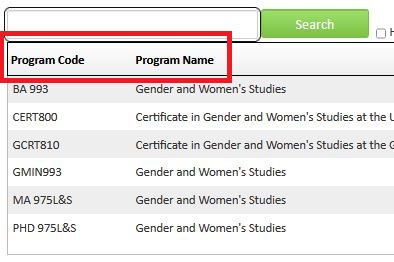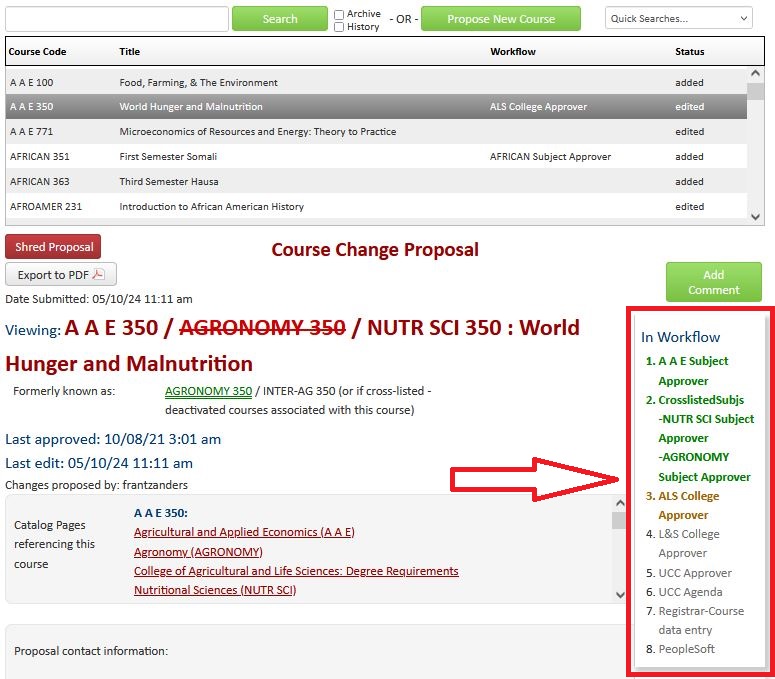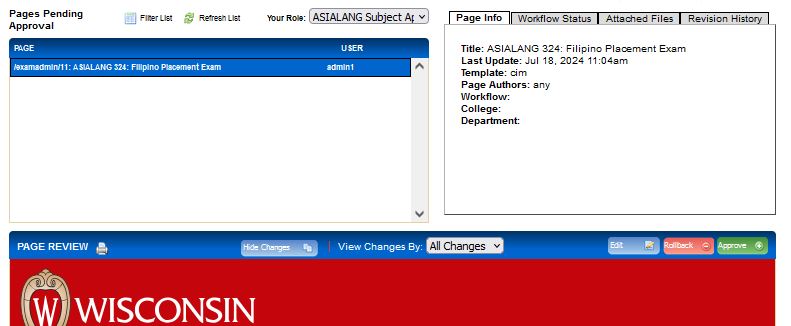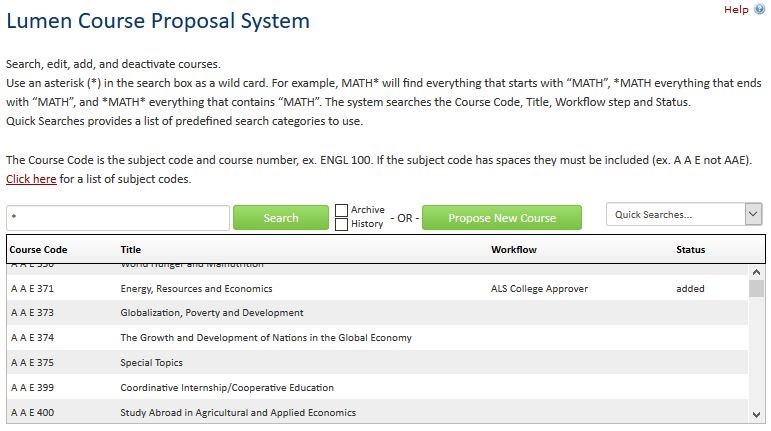Topics Map > Lumen Exams
Lumen Exams: Overview and System Functionality
- About Lumen Exams
- Searching for a proposal
- How to start/edit a proposal
- Saving or submitting a proposal
- Lumen Exams workflow
- Checking the status of a proposal
- Email notifications
- Red/green markup
- Entering comments
- Removing a proposal from the approval process (shredding)
- Linking to a specific proposal
About Lumen Exams
Lumen Exams manages proposals to create new or make changes to existing placement tests or credit by exam or credit by portfolio review. Placement tests offered by UW System (Mathematics, English, Spanish, German and French) are not included, and are not updated in Lumen Exams.
Searching for a proposal
Step-by-step how-to
- Navigate to the landing page for the proposal type. Requires UW login.
- Enter your search in the field to the left of the green Search button.

- This can be the program name (full or partial). Do not use abbreviations or terms not in the official SIS description.
- This can be the key (found at the bottom right of the proposal).
- New programs will not have a code. Searching with an asterisk (*) will pull up all proposals and the new proposals filter to the top. The text that displays will show up in the second column (program transcript description, course title, etc.)
- Hit enter on your keyboard or click the green Search button.

Tips and tricks for searching Lumen
- Click on the header bar will sort the proposals based on the column you select i.e. clicking status will sort all programs based on their status, added, edited, deleted.
- Use an asterisk (*) as a wildcard.
- "Math*" returns results starting with Math (Mathematics, Math for...)
- "*Math*" returns results with "Math" listed somewhere in the title (Certificate in Math, Data Science and Mathematics...)
- "*Math" returns results where the last word is Math
- The search looks at the Code and Title field. These fields only use the exact title/name and do not use abbreviations.
- GCRT* pulls all graduate/professional certificates
- MS* pulls all master's degrees starting with MS (MS, MSB)
- If you are looking for a specific type of proposal, use the Quick Searches drop-down. These have pre-defined queries by module i.e. Lumen Courses has a different drop-down than Lumen Programs.

- Characters, such as apostrophes, reduce search optimization e.x. *Women's* returns no results, but "Women*s" returns 6 items.
Specific to Lumen Exams search tips
Exams are set-up in a way that you can search by:
- Course code (utilizing the correct subject short description and catalog number)
- Exam name, as entered in the proposal.
How to start/edit a proposal
Starting a proposal
- Click the green "Propose New Exam" button. This will open a new window.
- Select the type of exam you want. The form adjusts based on this question.

Editing a proposal
- Search for the proposal needing revisions. If a proposal is in workflow, you cannot edit the proposal via the landing page.
- Click on the proposal in the scrolly bar.
- Click the green "Edit Request" button. This will open a new window.

- Edit the proposal with desired changes.
- Save and submit to workflow.
Saving or submitting a proposal
The software does not automatically save proposals.
There are three ways to save a proposal:
- Click the "floating save" button (stays at the bottom of the browser as you scroll).
- Scroll to the very bottom of the proposal and click the gray "Save Changes." This will save changes and close the edit window. This does not submit to workflow.

- Scroll to the very bottom of the proposal and click the green "Start Workflow." This will close the window and submit the proposal to workflow if all required elements have been filled in. The proposal cannot be edited again from the landing page; additional revisions must be made in workflow by an approver or rolled out of workflow for any user to edit.

Submitting to workflow
When you have finalized your edits and are ready to start the approval process, click the "Start Workflow" button which can only be done when editing a proposal. All required fields must be filled in. If they are not, the form will automatically bump you up to the element that has not been populated.
Canceling changes
If you determine you do not want to save change, click the red "cancel" at the bottom of the form. 
If you clicked the "floating save", canceling will remove all change made since the last save (when you clicked the floating save). If you need to remove all changes that have been made/revert the proposal back to the last approved version, the proposal must be shredded.
Lumen Exams workflow
Workflow includes "conditional" steps of workflow, where by answering specific questions additional steps are added for specific governance body review. See the "if applicable" to see which proposals are conditional.
Typical workflow steps
- Subject approver
- Cross-list Subject approver (if applicable)
- School/College approver
- Cross-list School/College approver (if applicable)
- Graduate School (if the course is numbered 300+)
- Office of Student Learning Assessment (review of criteria and rubric)
- University Curriculum Committee
- Bursar (credit by exam and portfolio review proposals only)
- Registrar (Student Information System)
Checking the status of a proposal
If a proposal is "at rest" (the status is null/blank), there are no proposed revisions and the proposal is current. If there isn't a workflow step listed under the workflow column, the proposal is not in workflow. When a proposal is "in workflow," it lists the current step requiring sign-off in the scrolly bar. The example below is for courses, but the workflow status operates the same across the Lumen tools.
Step-by-step
The most up-to-date place to check the status of a proposal search for the proposal from the landing page:
- Navigate to the landing page for the proposal type. Requires UW login.
- Search for your proposal using the search functionality.

- Click on the proposal in the scrolly bar.

- Look at the "Workflow" column or the workflow steps on the right side of the proposal. If there is no status, the proposal is not in workflow.

Deciphering workflow by color
- The green steps mean the subject, school/college, or University Curriculum Committee has approved a course.
- Orange/Yellow means this is the current step of workflow.
- Gray means the proposal has not yet advanced to this step.

Email notifications
- All users in a workflow approver role must be included in the email notifications sent by the proposal system.
- Some users may wish to automatically direct these messages to a specific folder within their email account. General information regarding how to do this is available from the DoIT helpdesk. For consistency, it is highly recommended that you manage Inbox Rules via Outlook on the web. In addition, when you setup a rule in Outlook on the web the rule will be applied regardless of the client you are using.
- The subject lines start with:
- [Lumen Courses]
- [Lumen Badge]
- [Lumen Structures]
- [Lumen]
- [Lumen Programs]
- [Lumen Exams]
- The subject lines start with:
Post-approval email regarding catalog requisites
Requisites are administratively updated by the Course Specialist in the Office of the Registrar to reflect the inclusion of departmental placement exams. Once updated, DAPIR notifies the school/college academic planner(s) by email with the list of impacted courses.
Red/green markup
The software utilizes "red/green markup" to visually indicate where content has changed in a change proposal.
- Red means the text has been removed. The red uses strike-through to indicate it is being removed for accessibility.
- Green means the text has been added. Green uses double lines under the text to indicate new text for accessibility.
Entering comments
Comments may only be added to a proposal through the Approve Pages by a user who has edit/approver access in the current step of workflow.
Step-by-step how-to
- Navigate to the Approve Pages console, select the workflow step where the proposal sits, and click on the proposal. (Consult the help KB, if needed).
- Edit the proposal. This will open a new window.

- Scroll to the bottom of the form and add the comment text in the Reviewer Comments field.
- Click "Save Changes"

Removing a proposal from the approval process (shredding)
It is the responsibility of the proposer to ensure any proposal advances in a timely fashion.
Proposals that exceed the allotted time-frame per policy are "shredded" (removed/cancelled). Proposers are not notified of the shredding action. To ensure that your proposals do not get shredded, track them using the Lumen Tools viz1 (requires VPN and authentication) and ensure they progress through governance. Any proposal that reaches a university governance, DAPIR or Office of the Registrar workflow step will not be shredded.
If you have determined you no longer need a proposal (changes aren't needed, proposal was not approved), email lumen@provost.wisc.edu and specifying which proposal needs to be removed.
Notes
- Shredded proposals cannot be recovered, so retain a pdf version if you think you'll need it in the future.
- Shredded new courses will have no record of ever existing once shredded.
- Shredded change or deactivation (courses only) proposals will revert back to the most recently approved version of the proposal.
- Shredding can only happen to the entire proposal (i.e. specific parts of a proposal cannot be shredding while keeping other parts).
Footnote
Linking to a specific proposal
There is an easy way to create a direct link to a specific proposal in Lumen. Each proposal has a unique key behind the scenes that always links to that specific proposal.
Each URL has the same stem:
- Courses: https://next-guide.wisc.edu/courseadmin/?key=[insert key]
- Programs: https://next-guide.wisc.edu/programadmin/?key=[insert key]
- Structures: https://next-guide.wisc.edu/miscadmin/?key=[insert key]
- Exams: https://next-guide.wisc.edu/examadmin/?key=[insert key]
- Badges: https://next-guide.wisc.edu/badgeadmin/?key=[insert key]
Step-by-step how-to
- To find the unique key number navigate to either the landing page and select the proposal you wish to create a direct link for.
- Scroll to the bottom of the page. The key is in the bottom right corner of page.










